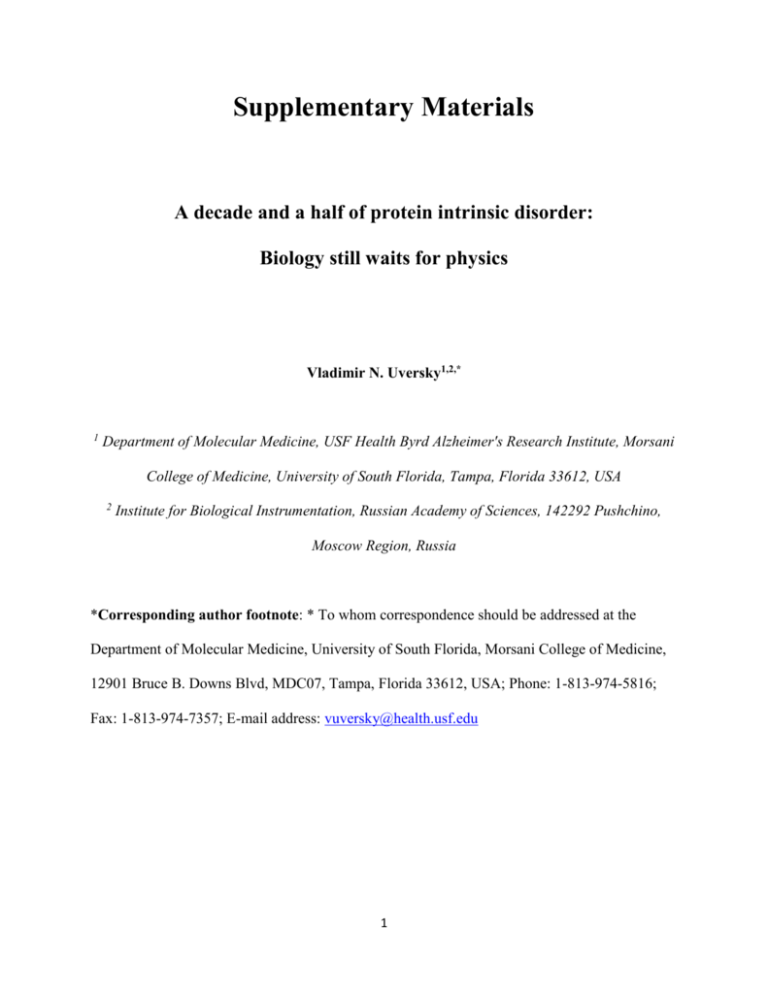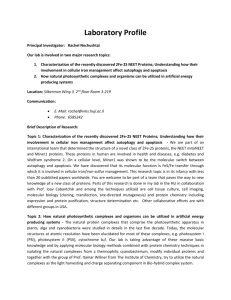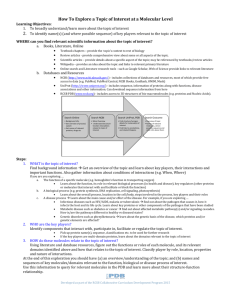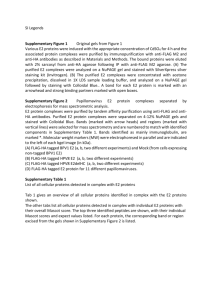pro2261-sup-0002-suppinfo
advertisement

Supplementary Materials A decade and a half of protein intrinsic disorder: Biology still waits for physics Vladimir N. Uversky1,2,* 1 Department of Molecular Medicine, USF Health Byrd Alzheimer's Research Institute, Morsani College of Medicine, University of South Florida, Tampa, Florida 33612, USA 2 Institute for Biological Instrumentation, Russian Academy of Sciences, 142292 Pushchino, Moscow Region, Russia *Corresponding author footnote: * To whom correspondence should be addressed at the Department of Molecular Medicine, University of South Florida, Morsani College of Medicine, 12901 Bruce B. Downs Blvd, MDC07, Tampa, Florida 33612, USA; Phone: 1-813-974-5816; Fax: 1-813-974-7357; E-mail address: vuversky@health.usf.edu 1 Peculiarities of disorder-based interactions Some illustrative examples of static complexes Some of the disorder-based complexes are relatively static and resemble complexes of ordered proteins. These complexes are suitable for the structure determination by X-ray crystallography and PDB contains numerous examples of these static complexes. Although the molecular mechanism of the formation of such complexes has its roots in induced folding, static complexes have very different morphologies and therefore can be classified according to their overall appearance.1 Some of the major groups of the disorder-based static complexes are molecular recognition features (MoRFs), wrappers, chameleons, penetrators, huggers, intertwined strings, long cylindrical containers, connectors, armature, tweezers and forceps, grabbers, tentacles, pullers, and stackers or β-arcs.1 These binding modes are shown in Figure 1S and briefly described below. MoRFs. MoRFs are short, interaction-prone intrinsically disordered protein segments that undergo disorder-to-order transitions upon binding and are often involved in molecular recognition.2-4 MoRFs, being identified as short structured fragments of disordered proteins involved in interaction with globular partners, were structurally classified according to their structures in the bound state: -MoRFs form -helices, β-MoRFs form β-strands, and ι-MoRFs form structures without a regular pattern of backbone hydrogen bonds.2, 4 A MoRF typically constitutes one contiguous segment fitted into a grove at the surface of the ordered partner. Flexible Wrappers. Some IDPs wrap around their ordered binding partners. Complexes of this type are polyvalent ordered complexes where several ordered segments of a disordered protein bind to disjoint and spatially distant binding sites on the surface of the globular protein. 2 Typically, the ordered segments of such wrapping IDPs are connected by the disordered regions. Secondary structure elements of wrappers almost do not possess intramolecular interactions, forming very intensive intermolecular contacts with binding partner.5-8 Many proteins interacting with DNA or RNA are flexible wrappers. For example, numerous transcription factors, regulatory proteins, and other proteins that interact with DNA contain multiple zinc finger motifs. The zinc finger motifs act as independently folded globular domains that are separated by flexible linker regions. Zinc finger domains are disordered in the absence of zinc. Proteins often contain multiple zinc fingers connected by flexible linkers and wrap around the DNA in a spiral manner. The zinc finger-containing proteins typically interact with the major groove along the double helix of DNA. In the bound state, the zinc fingers are arranged around the DNA strand in such a way that the α-helix of each finger contacts the DNA, forming an almost continuous stretch of α-helices around the DNA molecule.9 Penetrators. In complexes of some IDPs with other proteins or RNA, significant parts of IDPs penetrate deep inside the structure of their binding partners. For example, in the crystal structure of the 30S ribosome, many ribosomal proteins, in addition to globular domains contained extended internal loops or long N- or C-terminal extensions that were not seen in structures of the isolated proteins, but which were associated intimately with the RNA inside the ribosome.10 The most illustrative example of this penetrating mode is S12, which has a globular domain at the interface side and a long N-terminal extension that threads its way through the 30 S subunit to emerge on the back side to interact with proteins S8 and S17.10 Huggers. Typically, monomers constituting the oligomers formed as a result of folding coupled to binding are highly intertwined,11-13 effectively “hugging” each other. Typically, 3 complexes of this kind are binary. There are however several examples of group huggers, where monomers clasp more than one partner. Intertwined strings. Coiled coils represent a common structural motif in proteins, where up to 7 long -helices are intertwined similar to strands of a rope.14-15 This motif is formed by approximately 3-5 % of all amino acids in proteins,16 with the most common members of this family being dimers and trimers. Individual -helices in coiled coil are wrapped around each other in a left-handed helix to form a supercoil. In addition to the left-handed coiled coils there are right-handed coiled coils.17-18 Coiled coils represent relatively simple but tightly packed structure. Importantly, partners involved in the coiled-coil formation are typically disordered in the non-bound form. Long cylindrical containers. Multichain coiled coils can assemble into long hollow cylinders containing a continuous axial pore with binding capacities for several hydrophobic compounds.19 Connectors and armature. Being formed, coiled-coils can be used for the subsequent formation of higher order oligomers, where segment of coiled-coils are used to bring oligomeric partners together.20-22 A coiled coil can serve as an armature, around which more complex structure is built.23-24 Tweezers and forceps. Many transcription factors form coiled-coil dimers that interact with DNA. Here, the coiled-coil dimer grips the major grove of DNA in a forceps-like manner.25 Grabbers. In several instances, the ends of the coiled-coil form an extensive β-sheet interaction with binding partners.26 4 Tentacles. In its crystal structure, the hexameric molecular chaperone prefoldin resembles a jellyfish with body consisting of a double β-barrel assembly, from which six long tentacle-like coiled-coils are protruding. The distal regions of the coiled-coils contain hydrophobic patches which are utilized for the multivalent binding of nonnative proteins.27 Pullers. The Thermus thermophilus chaperone ClpB is a two-tiered hexameric ring with a set of 85 Å-long mobile coiled-coils that are located on the outside of the hexamer and act as mechanical pullers.28 Here, the concerted motions of these coiled-coils cause adjacent subunits to move in opposite directions generating the mechanical force required to pull aggregate apart.28 Chameleons. One of the most unique features of IDPs is their ability to gain, in a templatedependent manner, very different structures in the bound form. This capability is illustrated by the C-terminal binding region of p53, the same short segment of which binds to four unrelated partners adopting different conformations (an -helix, a β-sheet, and two differently laid irregular structures) when bound to the different partners.29-31 Stackers or β-arcs. The unifying model of the amyloid fibrils is "β-arcades," which are the columnar structures produced by in-register stacking of "β-arcs", strand-turn-strand motifs in which the two β-strands interact via their side chains, not via the polypeptide backbone as in a conventional β-hairpin.32 From everything discussed above and from data abundantly present in modern protein literature, one can envision several plausible mechanisms of involvement of structural changes in protein functions. Often, these function-related structural changes in a protein molecule are induced by binding of specific partners (ligands, substrates, effectors, inhibitors, activators, etc.). 5 Binding of partners to ordered proteins can be described in terms of lock-and-key,33 induced fit3435 or conformational selection models,36-41 all of which assume that the pre-bound form is a structured protein or an ensemble of differently folded conformations.42 On the other hand, the lack of fixed structure combined with the high level of intrinsic dynamics and almost unrestricted flexibility at various structural levels provides IDPS and IDPRs (among many other advantages) with unprecedented possibility to bind to multiple structurally unrelated partners43-47 and adopt different structures upon binding to different partners.48-54 These binding modes clearly represent a new type of interactions not contained within the classical molecular recognition mechanisms. In fact, neither the lock-and-key33 nor the original induced-fit34-35 mechanisms can readily explain how one protein can bind to multiple partners, or how a protein can form fuzzy complexes, or can be involved in the formation of the semi-static complexes.1 Although the formation of static IDP/IDPR-based complexes with very unusual spatial configurations can be considered in terms of the extended induced fit and/or conformational selection mechanisms described for complexes of ordered proteins, new models are needed for the description of the molecular mechanisms of the formation of highly specific complexes without any (or almost any) ordered structure (so called fuzzy complexes). Figure S2 gives a schematic representation of various models proposed for the description of interaction mechanisms of ordered proteins and IDPs.42 The conformational flexibility allowed by different binding models in the unbound and bound states is also schematically represented. In Figure S2, areas with blue shades correspond to static complexes formed by ordered proteins and IDPs, whereas shades of red describe dynamic complexes formed by IDPs/IDPRs. Generally speaking, known function-related structural changes range from the local partial folding to complete folding in IDPs/IDPRs, and from allosteric transitions to induced fit adjustments in ordered proteins and domains. 6 References 1. Uversky VN (2011) Multitude of binding modes attainable by intrinsically disordered proteins: a portrait gallery of disorder-based complexes. Chem Soc Rev. 2. Mohan A. MoRFs: A dataset of Molecular Recognition Features. (2006) The School of Informatics. Indiana University, Indianapolis, pp. 59. 3. Oldfield CJ, Cheng Y, Cortese MS, Romero P, Uversky VN, Dunker AK (2005) Coupled folding and binding with alpha-helix-forming molecular recognition elements. Biochemistry 44:12454-12470. 4. Vacic V, Oldfield CJ, Mohan A, Radivojac P, Cortese MS, Uversky VN, Dunker AK (2007) Characterization of molecular recognition features, MoRFs, and their binding partners. J Proteome Res 6:2351-2366. 5. Galea CA, Nourse A, Wang Y, Sivakolundu SG, Heller WT, Kriwacki RW (2008) Role of intrinsic flexibility in signal transduction mediated by the cell cycle regulator, p27 Kip1. J Mol Biol 376:827-838. 6. Galea CA, Wang Y, Sivakolundu SG, Kriwacki RW (2008) Regulation of cell division by intrinsically unstructured proteins: intrinsic flexibility, modularity, and signaling conduits. Biochemistry 47:7598-7609. 7. Galea CA, High AA, Obenauer JC, Mishra A, Park CG, Punta M, Schlessinger A, Ma J, Rost B, Slaughter CA, Kriwacki RW (2009) Large-scale analysis of thermostable, mammalian proteins provides insights into the intrinsically disordered proteome. Journal of proteome research 8:211-226. 8. Graham TA, Weaver C, Mao F, Kimelman D, Xu W (2000) Crystal structure of a betacatenin/Tcf complex. Cell 103:885-896. 9. Luscombe NM, Austin SE, Berman HM, Thornton JM (2000) An overview of the structures of protein-DNA complexes. Genome Biol 1:REVIEWS001. 10. Brodersen DE, Clemons WM, Jr., Carter AP, Wimberly BT, Ramakrishnan V (2002) Crystal structure of the 30 S ribosomal subunit from Thermus thermophilus: structure of the proteins and their interactions with 16 S RNA. J Mol Biol 316:725-768. 11. Teschke CM, King J (1992) Folding and assembly of oligomeric proteins in Escherichia coli. Curr Opin Biotechnol 3:468-473. 12. Xu D, Tsai CJ, Nussinov R (1998) Mechanism and evolution of protein dimerization. Protein Sci 7:533-544. 13. Gunasekaran K, Tsai CJ, Nussinov R (2004) Analysis of ordered and disordered protein complexes reveals structural features discriminating between stable and unstable monomers. J Mol Biol 341:1327-1341. 14. Mason JM, Arndt KM (2004) Coiled coil domains: stability, specificity, and biological implications. Chembiochem 5:170-176. 7 15. Liu W, Rui H, Wang J, Lin S, He Y, Chen M, Li Q, Ye Z, Zhang S, Chan SC, Chen YG, Han J, Lin SC (2006) Axin is a scaffold protein in TGF-beta signaling that promotes degradation of Smad7 by Arkadia. Embo J 25:1646-1658. 16. Wolf E, Kim PS, Berger B (1997) MultiCoil: a program for predicting two- and threestranded coiled coils. Protein Sci 6:1179-1189. 17. Harbury PB, Plecs JJ, Tidor B, Alber T, Kim PS (1998) High-resolution protein design with backbone freedom. Science 282:1462-1467. 18. Stetefeld J, Jenny M, Schulthess T, Landwehr R, Engel J, Kammerer RA (2000) Crystal structure of a naturally occurring parallel right-handed coiled coil tetramer. Nat Struct Biol 7:772-776. 19. Ozbek S, Engel J, Stetefeld J (2002) Storage function of cartilage oligomeric matrix protein: the crystal structure of the coiled-coil domain in complex with vitamin D(3). EMBO J 21:5960-5968. 20. Low HH, Moncrieffe MC, Lowe J (2004) The crystal structure of ZapA and its modulation of FtsZ polymerisation. J Mol Biol 341:839-852. 21. Zhao X, Ghaffari S, Lodish H, Malashkevich VN, Kim PS (2002) Structure of the Bcr-Abl oncoprotein oligomerization domain. Nat Struct Biol 9:117-120. 22. Liu X, Xu L, Liu Y, Tong X, Zhu G, Zhang XC, Li X, Rao Z (2009) Crystal structure of the hexamer of human heat shock factor binding protein 1. Proteins 75:1-11. 23. Malashkevich VN, Schneider BJ, McNally ML, Milhollen MA, Pang JX, Kim PS (1999) Core structure of the envelope glycoprotein GP2 from Ebola virus at 1.9-A resolution. Proc Natl Acad Sci U S A 96:2662-2667. 24. Malashkevich VN, Singh M, Kim PS (2001) The trimer-of-hairpins motif in membrane fusion: Visna virus. Proc Natl Acad Sci U S A 98:8502-8506. 25. Glover JN, Harrison SC (1995) Crystal structure of the heterodimeric bZIP transcription factor c-Fos-c-Jun bound to DNA. Nature 373:257-261. 26. Im YJ, Kang GB, Lee JH, Park KR, Song HE, Kim E, Song WK, Park D, Eom SH (2010) Structural basis for asymmetric association of the betaPIX coiled coil and shank PDZ. J Mol Biol 397:457-466. 27. Siegert R, Leroux MR, Scheufler C, Hartl FU, Moarefi I (2000) Structure of the molecular chaperone prefoldin: unique interaction of multiple coiled coil tentacles with unfolded proteins. Cell 103:621-632. 28. Lee S, Sowa ME, Watanabe YH, Sigler PB, Chiu W, Yoshida M, Tsai FT (2003) The structure of ClpB: a molecular chaperone that rescues proteins from an aggregated state. Cell 115:229-240. 29. Uversky VN, Dunker AK (2010) Understanding protein non-folding. Biochim Biophys Acta 1804:1231-1264. 30. Oldfield CJ, Meng J, Yang JY, Yang MQ, Uversky VN, Dunker AK (2008) Flexible nets: disorder and induced fit in the associations of p53 and 14-3-3 with their partners. BMC Genomics 9 Suppl 1:S1. 8 31. Hsu WL, Oldfield CJ, Xue B, Meng J, Huang F, Romero P, Uversky VN, Dunker AK (2013) Exploring the binding diversity of intrinsically disordered proteins involved in one-tomany binding. Protein Sci 22:258-273. 32. Kajava AV, Baxa U, Steven AC (2010) Beta arcades: recurring motifs in naturally occurring and disease-related amyloid fibrils. Faseb J 24:1311-1319. 33. Fischer E (1894) Einfluss der configuration auf die wirkung der enzyme. Ber Dt Chem Ges 27:2985-2993. 34. Koshland DE, Jr., Ray WJ, Jr., Erwin MJ (1958) Protein structure and enzyme action. Fed Proc 17:1145-1150. 35. Koshland DE, Jr. (1958) Application of a theory of enzyme specificity to protein synthesis. Proc Natl Acad Sci USA 44:98-104. 36. Careri G, Fasella P, Gratton E (1975) Statistical time events in enzymes: a physical assessment. CRC Crit Rev Biochem 3:141-164. 37. Ma B, Kumar S, Tsai CJ, Nussinov R (1999) Folding funnels and binding mechanisms. Protein Eng 12:713-720. 38. Tsai CJ, Ma B, Nussinov R (1999) Folding and binding cascades: shifts in energy landscapes. Proc Natl Acad Sci U S A 96:9970-9972. 39. Tsai CJ, Kumar S, Ma B, Nussinov R (1999) Folding funnels, binding funnels, and protein function. Protein Sci 8:1181-1190. 40. Tobi D, Bahar I (2005) Structural changes involved in protein binding correlate with intrinsic motions of proteins in the unbound state. Proc Natl Acad Sci U S A 102:18908-18913. 41. Frauenfelder H, Sligar SG, Wolynes PG (1991) The energy landscapes and motions of proteins. Science 254:1598-1603. 42. Uversky VN (2013) Intrinsic disorder-based protein interactions and their modulators. Curr Pharm Des. 43. Patil A, Nakamura H (2006) Disordered domains and high surface charge confer hubs with the ability to interact with multiple proteins in interaction networks. FEBS Lett 580:20412045. 44. Haynes C, Oldfield CJ, Ji F, Klitgord N, Cusick ME, Radivojac P, Uversky VN, Vidal M, Iakoucheva LM (2006) Intrinsic disorder is a common feature of hub proteins from four eukaryotic interactomes. PLoS Comput Biol 2:e100. 45. Ekman D, Light S, Bjorklund AK, Elofsson A (2006) What properties characterize the hub proteins of the protein-protein interaction network of Saccharomyces cerevisiae? Genome Biol 7:R45. 46. Dosztanyi Z, Chen J, Dunker AK, Simon I, Tompa P (2006) Disorder and sequence repeats in hub proteins and their implications for network evolution. J Proteome Res 5:29852995. 47. Singh GP, Ganapathi M, Sandhu KS, Dash D (2006) Intrinsic unstructuredness and abundance of PEST motifs in eukaryotic proteomes. Proteins 62:309-315. 9 48. Landsteiner K. 1936. The Specificity of Serological Reactions, Courier Dover Publications, Mineola, New York. 49. Pauling L (1940) A theory of the structure and process of formation of antibodies. J Am Chem Soc 62:2643-2657. 50. Karush F (1950) Heterogeneity of the binding sites of bovine serum albumin. J Am Chem Soc 72:2705-2713. 51. Meador WE, Means AR, Quiocho FA (1993) Modulation of calmodulin plasticity in molecular recognition on the basis of x-ray structures. Science 262:1718-1721. 52. Kriwacki RW, Hengst L, Tennant L, Reed SI, Wright PE (1996) Structural studies of p21Waf1/Cip1/Sdi1 in the free and Cdk2-bound state: conformational disorder mediates binding diversity. Proc Natl Acad Sci U S A 93:11504-11509. 53. Uversky VN (2003) Protein folding revisited. A polypeptide chain at the folding-misfoldingnonfolding cross-roads: which way to go? Cell Mol Life Sci 60:1852-1871. 54. Dunker AK, Garner E, Guilliot S, Romero P, Albrecht K, Hart J, Obradovic Z, Kissinger C, Villafranca JE (1998) Protein disorder and the evolution of molecular recognition: theory, predictions and observations. Pac Symp Biocomput:473-484. 55. Mittag T, Kay LE, Forman-Kay JD (2010) Protein dynamics and conformational disorder in molecular recognition. J Mol Recognit 23:105-116. 10 Figure legends Figure S1. A portrait gallery of disorder-based complexes. Illustrative examples of various interaction modes of intrinsically disordered proteins are shown. A. MoRFs. a, -MoRF, a complex between the botulinum neurotoxin (red helix) and its receptor (a blue cloud) (PDB ID: 2NM1); b, i-MoRF, a complex between an 18-mer cognate peptide derived from the 1 subunit of the nicotinic acetylcholine receptor from Torpedo californica (red helix) and -cobratoxin (a blue cloud) (PDB ID: 1LXH). B. Wrappers. a, rat PP1 (blue cloud) complexed with mouse inhibitor-2 (red helices) (PDB ID: 2O8A); b, a complex between the paired domain from the Drosophila paired (prd) protein and DNA (PDB ID: 1PDN). C. Penetrator. Ribosomal protein s12 embedded into the rRNA (PDB ID: 1N34). D. Huggers. a, E. coli trp repressor dimer (PDB ID: 1ZT9); b, tetramerization domain of p53 (PDB ID: 1PES); c, tetramerization domain of p73 (PDB ID: 2WQI). E. Intertwined strings. a, dimeric coiled coil, a basic coiled-coil protein from Eubacterium eligens ATCC 27750 (PDB ID: 3HNW); b, trimeric coiled coil, salmonella trimeric autotransporter adhesin, SadA (PDB ID: 2WPQ); c, tetrameric coiled coil, the virionassociated protein P3 from Caulimovirus (PDB ID: 2O1J). F. Long cylindrical containers. a, pentameric coiled coil, side and top views of the assembly domain of cartilage oligomeric matrix protein (PDB ID: 1FBM); b, side and top views of the seven-helix coiled coil, engineered version of the GCN4 leucine zipper (PDB ID: 2HY6). G. Connectors. a, human heat shock factor binding protein 1 (PDB ID: 3CI9); b, the bacterial cell division protein ZapA from Pseudomonas aeruginosa (PDB ID: 1W2E). H. Armature. a, side and top views of the envelope glycoprotein GP2 from Ebola virus (PDB ID: 2EBO); b, side and top views of a complex between the N- and C-terminal peptides derived from the membrane fusion protein of the Visna (PDB ID: 1JEK). I. Tweezers or forceps. A complex between c-Jun, c-Fos and DNA. Proteins 11 are shown as red helices, whereas DNA is shown as a blue cloud (PDB ID: 1FOS). J. Grabbers. Structure of the complex between βPIX coiled coil (red helices) and Shank PDZ (blue cloud) (PDB ID: 3L4F). K. Tentacles. Structure of the hexameric molecular chaperone prefoldin from the archaeum Methanobacterium thermoautotrophicum (PDB ID: 1FXK). L. Pullers. Structure of the ClpB chaperone from Thermus thermophilus (PDB ID: 1QVR). M. Chameleons. The Cterminal fragment of p53 gains different types of secondary structure in complexes with four different binding partners, cyclinA (PDB ID: 1H26), sirtuin (PDB ID: 1MA3), CBP bromo domain (PDB ID: 1JSP), and s100 (PDB ID: 1DT7). N. Stackers or -arcs. a, stack of arches, -amyloid; b, superpleated -structure (Sup35p, Ure2P, -synuclein); c, stack of solenoids (prion); d, stack of -arch dimers (insulin); e, -solenoids. Modified from 32 . O. Dynamic complexes. Schematic representation of the polyelectrostatic model of Sic1-Cdc4 interaction. Schematic representation of an IDP (ribbon) interacting with a folded receptor (gray shape) through several distinct binding motifs and an ensemble of conformations (indicated by four representations of the interaction). The intrinsically disordered protein possesses positive and negative charges (depicted as blue and red circles, respectively) giving rise to a net charge ql, while the binding site in the receptor (light blue) has a charge qr. The effective distance <r> is between the binding site and the centre of mass of the intrinsically disordered protein. Reproduced from ref.55 Figure S2. Various models proposed for the description of binding mechanisms of ordered (A) and intrinsically disordered proteins (B). Insert schematically compares scales of allowed structural fluctuations, with sizes of circles and ovals being roughly proportional to the degree of the conformational freedom. Reproduced from ref.42 12 Figure S1 13 Figure S2 14







